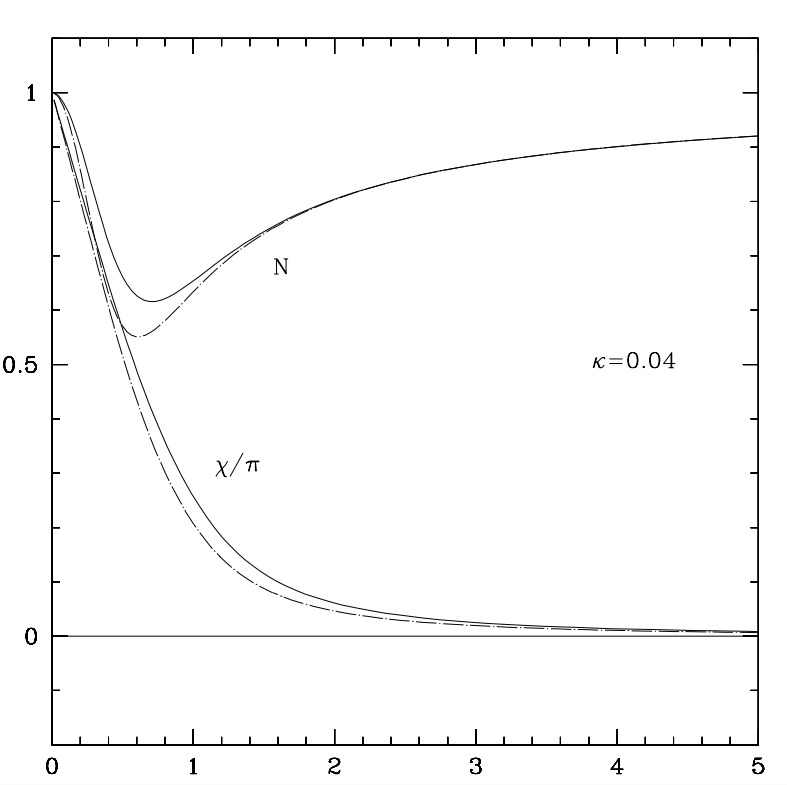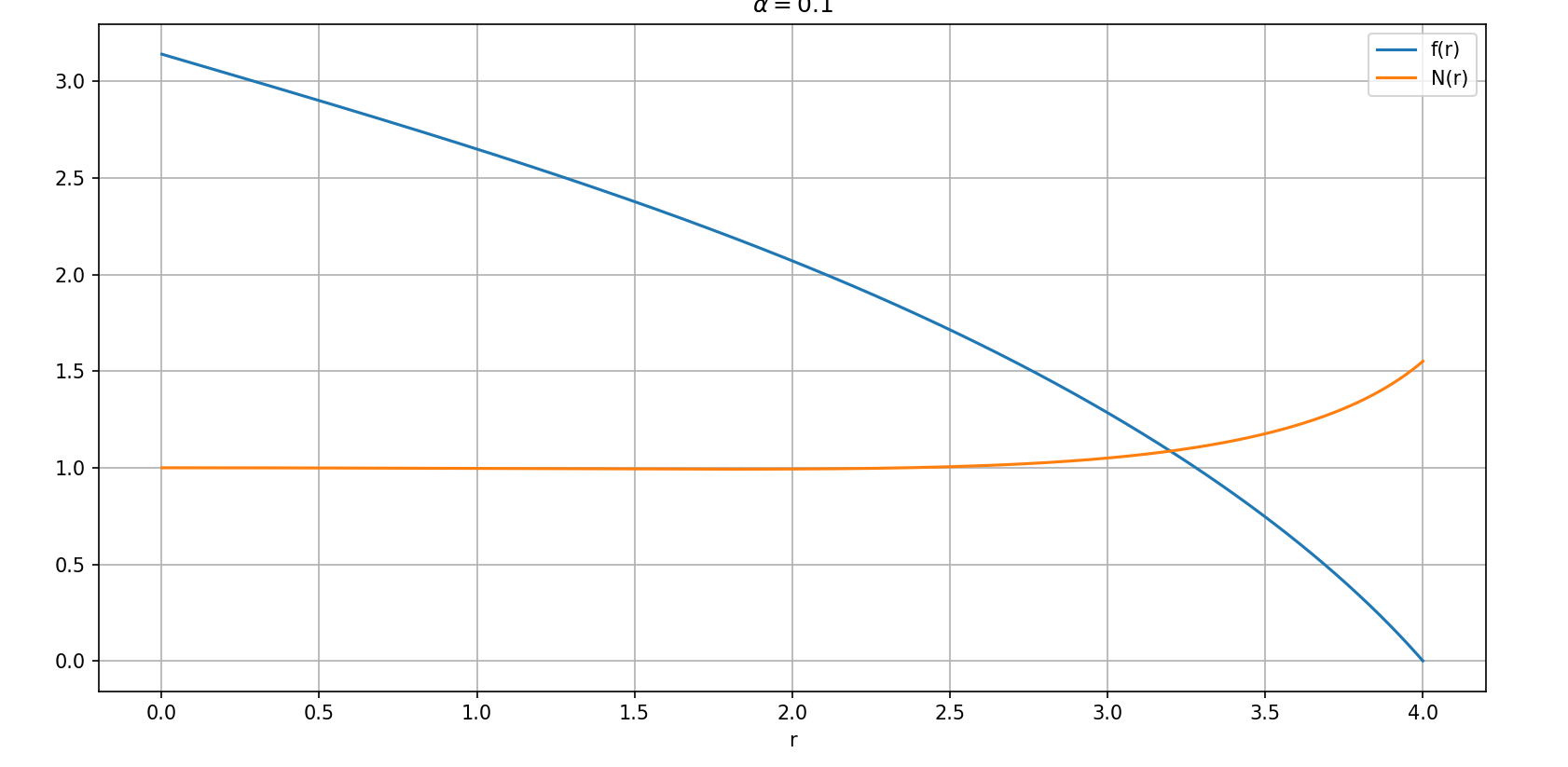I am trying to solve three coupled differential equations in Python. I am using RK-4 techniques with Shooting method. I am trying to plot the f and N functions.
import numpy as np
import matplotlib.pyplot as plt
from scipy.optimize import fsolve
alpha = 0.1
def F(r, f, v, N, sig):
g = np.sin(f)
h = np.cos(f)
i = np.sin(2 * f)
dfdr = v
dNdr = -(alpha*r**2 * N * v**2 *(r**2 + 2 * g**2)+alpha * g**2 * (g**2 +2* r**2) + r**2*(N-1))/r**3
dsigdr = ( alpha * sig * v**2 * (r**2 + 2 * g**2)) / r
f1= v*((2 * dsigdr * g**2)/(sig * r**2)+(2 * dNdr * g**2)/(N * r**2)+((dsigdr)/sig +dNdr / N + 2 / r))
dvdr = -(f1 -i/(N * r**2)+(-(2 * g**3 * h)/(N * r**4)+(v**2 * i)/r**2)) / (1 + (2 * g**2) / r**2)
return [dfdr, dNdr, dsigdr, dvdr]
def rk4(F, r_range, f0, v0, N0, s0, h):
r_values = np.arange(r_range[0], r_range[1], h)
f_values = np.linspace(f0, 0, len(r_values))
v_values = np.linspace(v0, 0, len(r_values))
N_values = np.linspace(N0, 1, len(r_values))
S_values = np.linspace(s0, 1, len(r_values))
for i in range(1, len(r_values)):
r = r_values[i-1]
f = f_values[i-1]
v = v_values[i-1]
N = N_values[i-1]
sig = S_values[i-1]
k1f, k1v, k1N, k1S = F(r, f, v, N, sig)
k2f, k2v, k2N, k2S = F(r + 0.5*h, f + 0.5*k1f*h, v + 0.5*k1v*h, N + 0.5*k1N*h, sig +0.5*k1S*h)
k3f, k3v, k3N, k3S = F(r + 0.5*h, f + 0.5*k2f*h, v + 0.5*k2v*h, N + 0.5*k2N*h, sig +0.5*k2S*h)
k4f, k4v, k4N, k4S = F(r + h, f + k3f*h, v + k3v*h, N + k3N*h, sig + k3S*h)
f_values[i] = f + ((k1f + 2*k2f + 2*k3f + k4f)*h) / 6
v_values[i] = v + ((k1v + 2*k2v + 2*k3v + k4v)*h) / 6
N_values[i] = N + ((k1N + 2*k2N + 2*k3N + k4N)*h) / 6
S_values[i] = sig + ((k1S + 2*k2S + 2*k3S + k4S)*h)/ 6
return r_values, f_values, v_values, N_values, S_values
rmin = 0.001
rmax = 4
r_range=[rmin, rmax]
h = 0.00001
def objective(u):
v0, s0 = u
r_values, f_values, v_values, N_values, S_values = rk4(F, r_range, np.pi, v0, 1, s0, h)
y1 = f_values[-1]
y2 = S_values[-1]
print(f"Objective results: y1={y1}, y2={y2}")
return [y1 , y2 - 1]
initial_guess=[-0.478, -1.216]
v1 = fsolve(objective, initial_guess, xtol=1e-8)
print("The initial values of v0 and sig0 given by fsolve:", v1[0], " and ", v1[1])
r_values, f_values, v_values, N_values, S_values = rk4(F, [rmin, rmax], np.pi, v1[0], 1, v1[1], h)
y3 = f_values[-1]
y4 = S_values[-1]
print("The value of f and sig at outer boundary is:", y3, y4)
if np.abs(y3) < 1e-6 and 1<= y4 <1.1:
print("Boundary condition f(rmax) = 0 is satisfied, and the value of f at outer boundar is:", y3)
print("Boundary condition sig(rmax) = 0 is satisfied, and the value of sig at outer boundar is:", y4)
else:
print("The solutions did not converge")
plt.figure(figsize=(14, 10))
plt.plot(r_values, f_values, label='f(r)')
plt.plot(r_values, N_values, label='N(r)')
plt.title(r"$\alpha=0.1$")
plt.xlabel('r')
plt.grid()
plt.legend()
plt.show()
But the nature of the plot is completely different from my expectations. The output is
Objective results: y1=0.000372840219254553, y2=1.0001907509516712
Objective results: y1=0.000372840219254553, y2=1.0001907509516712
Objective results: y1=0.000372840219254553, y2=1.0001907509516712
Objective results: y1=0.00037294172854991653, y2=1.0001906882951273
Objective results: y1=0.000372824083910513, y2=1.0001907727358128
Objective results: y1=1.8398001535383646e-07, y2=0.9999999172810013
Objective results: y1=1.1072732970996606e-11, y2=1.0000000000024691
Objective results: y1=2.1284157569008075e-12, y2=0.9999999999969905
Objective results: y1=1.1784771089214975e-13, y2=0.9999999999997673
The initial values of v0 and sig0 given by fsolve: -0.4780664768861783 and -1.2166450055671914
The value of f and sig at the outer boundary is: 1.1784771089214975e-13 0.9999999999997673
The solutions did not converge
As you see the value of sig at the outer boundary is almost one (0.9999999999997673).
[This is the nature of the plot as expected
 ]
][This is the plot I am getting
 ]
][These are the three coupled differential equations with boundary conditions
 ]
]
I also tried the above code with a smaller value of h (=0.000001) and different values of rmin, rmax, alpha and initial_guess but the result was the same.
I also tried to solve the problem using solve_bvp. Here is the code using solve_bvp
import numpy as np
from scipy.integrate import solve_bvp
import matplotlib.pyplot as plt
alpha = 0.1
def F(r, f):
#f, v, N, sig = S
g = np.sin(f[0])
h = np.cos(f[0])
i = np.sin(2 * f[0])
#dfdr = v
dNdr = -( alpha * r**2 * f[2] * f[1]**2 * (r**2 + 2* g**2) + alpha * g**2 * (g**2 +2* r**2) + r**2 * (f[2] - 1)) / r**3
dsigdr = ( alpha * f[3] * f[1]**2 * (r**2 + 2 * g**2)) / r
ter1=((dsigdr) / f[3] + dNdr / f[2] + 2 / r +(2 * dsigdr * g**2) / (f[3] * r**2) + (2 * dNdr* g**2) / (f[2] * r**2))
dvdr = -((f[1] * ter1 - i / (f[2] * r**2)) + (-(2 * g**3 * h) / (f[2] * r**4) + (f[1]**2 * i) / r**2)) / (1 + (2 * g**2) / r**2)
return np.vstack((f[1], dvdr, dNdr, dsigdr))
def bc(fa, fb):
return np.array([fa[0]-np.pi, fb[0]-0, fa[2]-1, fb[3]-1])
rmin = 0.001
rmax = 5
x = np.linspace(rmin, rmax, 100000)
y=np.ones([4, x.size])
y[0, :] = np.linspace(np.pi, 0, x.size)
y[1, :] = np.linspace(-0.2, 0, x.size)
y[2, :] = np.linspace(1, 1, x.size)
y[3] = np.ones(x.size)
sol = solve_bvp(F, bc, x, y, tol=1e-8, max_nodes=100000, verbose=2)
if sol.success:
print("Solution converged")
else:
print("Solution did not converge")
print("Residuals:", sol.message)
print("Residuals max:", np.max(sol.rms_residuals))
print(sol)
#Plot the solutions
plt.figure(figsize=(14, 10))
plt.plot(sol.x, sol.y[0], label='f(r)')
#plt.plot(sol.x, sol.y[1], label='V(r)')
plt.plot(sol.x, sol.y[2], label='N(r)')
plt.xlabel('r')
plt.grid()
plt.legend()
plt.show()
When I am using solve_bvp, I am getting the following error
Iteration Max residual Max BC residual Total nodes Nodes added
1 1.06e+00 3.41e-21 100000 (199998)
Number of nodes is exceeded after iteration 1.
Maximum relative residual: 1.06e+00
Maximum boundary residual: 3.41e-21
Solution did not converge
Residuals: The maximum number of mesh nodes is exceeded.
Residuals max: 1.0570652692628755
message: 'The maximum number of mesh nodes is exceeded.'
niter: 1
p: None
rms_residuals: array([4.25858920e-01, 2.54417888e-01, 1.98041640e-01, ...,
6.12622641e-05, 6.11022248e-05, 6.09430998e-05])
sol: <scipy.interpolate._interpolate.PPoly object at 0x000001B21E651DF0>
status: 1
success: False
The plot using solve_bvp is better but the success status is false.
[ This plot is done using solve_bvp]
This plot is done using solve_bvp]
max_nodenodes. For such doubly singular problems I had good experience with an exponential grid, math.stackexchange.com/a/4421059/115115, scicomp.stackexchange.com/a/41185/6839, scicomp.stackexchange.com/a/41224/6839. So the initial grid has very few nodes, just enough to represent the initial guess well enough. The solver will refine the grid where necessary, where the interesting parts of the dynamic occur. $\endgroup$